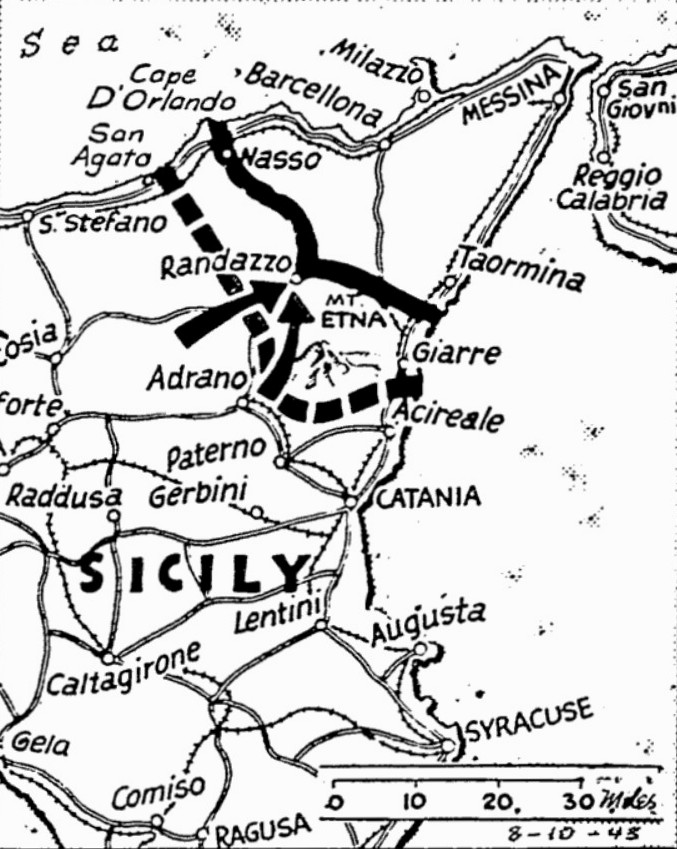The Pittsburgh Press (August 10, 1943)
Fleeing Nazis blow up roads, Allies smash ahead in Sicily
Americans, British merge near pass, trapping many of enemy
By Virgil Pinkley, United Press staff writer

Allies join forces in Sicily as U.S. and British columns (arrows) met near Randazzo Pass, trapping many German troops. The broken line shows the approximate battlefront, while the solid line denotes where the Axis forces are preparing a last stand.
Allied HQ, North Africa –
Retreating German troops have begun wholesale demolition of communications in northeast Sicily, impeding but failing to check a general Allied advance which effected a junction of the U.S. 7th and British 8th Armies between Randazzo Pass and the center of the line.
7th and 8th Army columns driving against Randazzo, key junction dominating the narrow defile between Mt. Etna and the Caronian Range, met west of the pass and plunged in today for a showdown battle expected to seal the fate of the cornered defenders of Sicily.
The junction of the American and British spearheads was believed to have cut off unknown numbers of German troops making a sacrificial stand before the mouth of the pass, one of the most vital Sicilian objectives remaining in Axis hands.
Blow up roads
The hard-pressed Germans, struggling to slow down the Allied advance in all sectors, started a campaign of blowing up roads on a scale never before witnessed in the Sicilian campaign, which went into its second month today.
Dynamite blasts in the wake of the Nazi withdrawal sent whole mountainsides crashing down on the roads. The Germans evidently realized that they were nearing the end of their fighting days and were embarking on an extravagant policy of demolition.
The only conquest of a town reported today – the capture of Pedara, five miles inland from Acireale by British forces straightening out their lines along the eastern seaboard – was no barometer of the steady Allied gains promising final victory within a matter of days.
Near Cape
On the north coast, the left wing of Lt. Gen. George S. Patton’s 7th Army forged ahead and was estimated to have reached a point less than five miles west of Capo d’Orlando.
It was west of the Cape that the 7th Army with U.S. Navy assistance turned the German flank Sunday morning in a landing now revealed to have been on a much larger scale than first indicated.
The original number of 300 prisoners capitulated by the Americans in the amphibious foray was boosted to 1,500, most of whom were described as Italians.
Drive 120 miles
The 7th Army was estimated to have advanced more than 120 miles and the 8th Army more than 80 since they stormed the Sicilian beaches a month ago.
A communiqué from the headquarters of Gen. Dwight D. Eisenhower confirmed the capture of Bronte, only nine miles from Randazzo, by a British 8th Army spearhead closing in around the road encircling Mt. Etna.
Northward, the communiqué said, the U.S. 7th Army, aided by knife-wielding French Moroccan Goums, “have continued to oppress eastward.” U.S. units were past Cesarò, only 12 miles west of Randazzo.
Shell coastal road
The position of the German and Italian forces “becomes daily more difficult,” the communiqué said.
British warships bombarded the eastern coastal road twice last weekend, it was revealed, while Allied aircraft heavily pounded Messina, the main Axis escape port, and communications through southern Italy. Six small enemy vessels were sunk along the Sicilian coast by fighter-bombers.
The landing in the Torrenova area east of Sant’Agata was disclosed to have resulted in a frantic withdrawal by enemy forces along the North Sicilian coast.
The new Axis line was believed to anchor on Capo d’Orlando in the north and follow the 23-mile-long road southeastward to Randazzo on the northwestern slope of Mt. Etna.
From Randazzo eastward, the Axis holds a 15-mile stretch of road that joins the coastal route near Fiumefreddo, about 13 miles north of Acireale. Thus, capture of Randazzo in the center would wedge the routes linking the Messina triangle.
Support landing
The bombardments on the east took place Saturday and Sunday nights near Taormina, north of Fiumefreddo, and at Riposto and Acireale before that point was taken. It was disclosed that heavy U.S. warships supported the northern coast landing with a bombardment of enemy positions.
Heavy Allied bombers plastered the Messina road junctions yesterday while other Allied planes continued the sweeps and patrols designed to prevent an Axis escape. Three enemy planes were destroyed while three Allied planes were missing.
